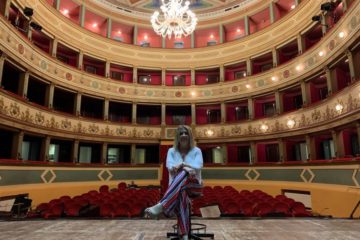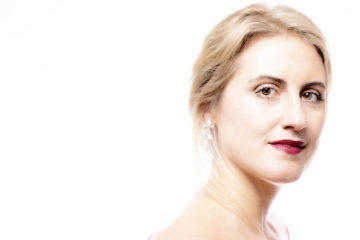Director Jennifer Williams is making the opera world more exciting. Bringing a non-traditional voice to an art form drowning in the conventional, Williams is exploring the use of technology – currently video projections – in opera, and digging deeper into the narratives of the standard repertory in an attempt to make the works more relatable and responsible. She is currently directing a world premiere that I couldn’t wait to find out more about. I am thrilled that she was willing to answer a few of my questions!
Tell me about Backwards from Winter, “an hour long operatic monodrama exploring a single woman’s reflection on a love relationship.” It sounds fascinating and ideally suited to a modern audience: electric sounds, relatively straightforward plot, and only an hour long. Is this work catering to younger crowds? Describe the audience profile you expect to see during its run.

Director Jennifer Williams
Photo credit: Fay Fox
My perspective is that it speaks to anyone who is up for a little adventure – who is interested in seeing a theme as old as humanity – love and loss – and an old art form approached from a more modern perspective. Between the electric instrumentation, intimate venue, video projections, and scenic installation (which looks more like an art installation at MoMA than an opera set), this is the kind of performance experience one would expect to find in New York in the 21st century.
Backwards from Winter is a great first opera to see, and I hope there are a lot of first-time operagoers for its world premiere. It’s in English with projected text; it’s “up close and personal;” it’s designed to be modern and inviting. Witnessing a world premiere is a thrill, regardless of whether you have never been to an opera before or if you are a season subscriber at a big house. No one has heard this music before. You are helping bring a new opera into existence. After all, the difference between a rehearsal and a performance is the audience.
After all, the difference between a rehearsal and a performance is the audience.
Let’s talk about the connection between the seasons and the stages of the relationship being explored in Backwards from Winter. How and why does the natural world play a role in this work? How do you capture the feeling of the seasons in the theater?
In speaking with the creators, composer Douglas Knehans’ immediate impulse was that the story wanted to be told in four parts, in four distinct movements. Librettist Juanita Rockwell was then drawn to the idea of the four seasons. Her work is informed by Buddhist philosophy, so the connection between the individual and the universe, the world around her, was a natural one. Unlike Vivaldi’s Four Seasons, this story moves backwards chronologically – a bit like Harold Pinter’s play Betrayal or Jason Robert Brown’s musical The Last Five Years (which moves both backwards and forwards, as it explores a relationship from two perspectives). Rather than seamlessly transitioning from one season into another, the opera jump-cuts from one season/scene to the next. It’s like a series of dreams, sometimes nightmares.
Douglas suggests the seasons in the score; the sounds evoke the sensations of the seasons and how they transform the natural world, almost like an Impressionist painting – like Monet or Van Gogh through a very modern lens. Because the sensation of the changing seasons permeates the sonic world, the logical extension was to bring it into the visual world.
I am always finding ways to engage with technology and modern life in my productions. At the moment, my main focus has been on video projections and finding new ways to use them onstage. In the world premiere of Backwards from Winter, the video projections designer Yee Eun Nam is creating for this production evoke the seasons in the same manner as the score – through impressions of their sensations: abstract image fragments and textures; or trees, vines and leaves that grow out of compartments she opens in the scenic installation, for instance. The projections are being mapped onto different surfaces rather than just a blank screen, which creates a more three-dimensional experience.
What are the main conflicts in Backwards from Winter?
At first glance, the conflict is between the unnamed woman, who is the main character of the opera, and her lost spouse. Other directors have pushed this idea to the forefront – adding a supernumerary to play the spouse or having him (though in fact, nothing in the soprano’s text indicates her spouse was necessarily male) be a looming presence scenically. I started digging deeper and took the world premiere production in a different direction. While the relationship is an important part of the story, it is her story – and the conflict is between this woman and her grief. Her own grief is her adversary, and I wanted to see her wrestle with it, try to excise it, come to terms with it onstage. In Douglas Knehans’ score, the electric cellist repeats fragments of her text the interludes, which follow each season like an echo, or like its shadow. It’s fascinating, beautiful and surreal. I see the electric cellist less as the literal embodiment of her deceased spouse and rather as the voice of her grief.
I wanted to put the female lead and this central conflict between her and her grief at the forefront by bringing the audience into the world of her memory – in an immersive way. Immersive design – in which the audience is fully immersed in the world of the opera, as opposed to a presentational design – is a big part of my work as a director. As the Founding Artistic Director of the experimental company DC Public Opera, I have created site-specific, immersive installations of Don Giovanni, Così fan tutte, La bohème, The Turn of the Screw, and Schubert’s Goethe-Lieder. My new productions of Mohammed Fairouz’s Sumeida’s Song and Ricky Ian Gordon and Royce Vavrek’s 27 also used immersive techniques. A problem with opera is that it can feel so closed off for many audiences, and immersive concepts make opera more inclusive and engaging. In the world premiere of Backwards from Winter, scenic installation designer Ryan Howell and I are creating a space that begins on the Thalia Theater stage and branches out into the audience. Grief, the electric cellist, is onstage and framed as a tree – a recurring image in Rockwell’s libretto, evoking the cycles of life and nature. Extending from Grief are branches, increasingly fragmented, and car debris, suspended above the audience. The visual gesture is like an explosion, evoking the automobile accident and its emotional impact. Onstage the woman is surrounded by photo boxes, moving boxes, suitcases – the different compartments of her memory she is sorting through, looking for a path forward. The scenic installation is all white and grayscale, and the technicolor video projections map all over the different surfaces. Everything in the space stems from Grief – it is a vortex that shapes the entire environment, from the moment the audience enters the theater.
A problem with opera is that it can feel so closed off for many audiences, and immersive concepts make opera more inclusive and engaging.
Do we ever learn the single woman’s name?
No – and I think that is really interesting. It invites the audience into the story, inviting you to fill it in with your own experiences. The easy response would be to say that it makes her story more “universal,” but it is more complex than that (and trying to present an experience as a universal one is always problematic, anyway). As both unnamed and the primary perspective through which the story is told, she reminds me of The Governess from The Turn of the Screw, or the unnamed central female characters in Charlotte Perkins Gilman’s The Yellow Wallpaper or Daphne du Maurier’s Rebecca. She is the 21st century’s answer to these characters.
We don’t learn the spouse’s name either, or the gender. I wanted to preserve that openness in the world premiere production. Rather than narrowing the story by jumping to the conclusion that her lost love is a man, there is no male character placed onstage, and the fragments of her lover we see in the video design are gender ambiguous and come in and out of focus, like a fading memory she is trying to hold on to. Creating inclusive experiences is deeply important to me. I want every audience member to come to my productions and feel that the story speaks to their lives and experiences.

Sumeida’s Song at Pittsburgh Opera, directed by Jennifer Williams
Photo credit: David Bachman
Your goal as a director is “to make opera more accessible without dumbing it down” – how do you do this? Is it possible to reach an audience that doesn’t have a foundation in operatic “vocabulary” with opera?
You’ve pinpointed the problem exactly: it’s this myth of opera vocabulary and etiquette that places it at a distance – as a members-only club, and all the baggage that comes with that idea. I shared that outlook on opera, which is why I am so interested in upending it. I was passionate about Shakespeare and Greek drama (I studied Greek drama in Athens and began learning Greek as an undergraduate) but avoided the opera; I felt it had nothing to do with me and my life and found everything about it off-putting. It wasn’t until I began my first job in opera that I decided to throw everything else away and dedicate my life to it. But I understand that other perspective very clearly.
My overarching goal as a director is to make the performances relevant and relatable to audiences, and to engage with modern life and culture rather than stand apart from it. For example, when I first came to opera, I was turned off by how the women were always victims (the “dying soprano” trope), but as I looked closer I saw that the music and underlying story elements didn’t always support that narrative. I decided to dig deeper, and in my productions I work to present women not as victims, but as empowered and in control of their own destinies. Many operas deal with abuses of power and power dynamics, but they don’t have to be disempowering. For instance, the Don Giovannis of the world gain their power by isolating women, but in that story ultimately the women come together and unite against him. In Bohème, Mimi makes the conscious choice to come back to Rodolfo even though she knows it will cost her her life, so she can be with him at the end – it’s a powerful, personal choice not to be alone when she dies, and she chooses to die on her own terms.
I was turned off by how the women were always victims (the “dying soprano” trope), but as I looked closer I saw that the music and underlying story elements didn’t always support that narrative. I decided to dig deeper…
Tell me about your views on technology in opera. What are some of the more unconventional uses of technology you’ve incorporated into your productions?
I love to incorporate new technology into my productions and play with audience expectations. At the moment, my focus is on video projection. I feel that we interact with screens so much in modern society, and so I try to explore the middle ground between staring at a screen by yourself on one hand, and on the other sitting in a theater surrounded by others, watching a live production. I think there’s much to explore in the intersection between these two poles, and I try to use video projections not as a means to provide cheap scenery, or to upstage or distract from singers, but rather to elucidate their inner thoughts, and augment the storytelling with another visual element that creates a different set of expectations.
Taking a bird’s-eye view of the opera world, I feel as though I do not see nearly as many women stage directors as men stage directors at the major opera houses. What’s going on there?
Good question. There’s a lot going on there.
I chose to position myself at an uncomfortable intersection: a woman directing, as well as a woman in classical music. Both are male-dominated worlds steeped in long histories of uncomfortable “traditions.” I am constantly negotiating both in order to do my job. One of the larger obstacles is the cult of genius, gendered male, common to both theater/directing and classical music. I have been very fortunate to work with employers and colleagues, particularly at the outset of my career, who were excited to work with a young female director with my artistic outlook and background, and they helped me create opportunities for myself to develop my voice as an artist and build my career.
There have also been other experiences.
I have known very clearly since the outset of my career what my artistic voice is, and that it is not traditional. Certainly there are a few great examples of brilliant women who have achieved international success – Francesca Zambello, Anne Bogart and Katie Mitchell come to mind. But if we are still congratulating ourselves for hiring women and working alongside them, we have work to do. Especially at this moment, there are producers, artists and audiences out there who are thrilled to engage with imaginative, innovative and intelligent women directors – and that’s great. It’s really time.
But if we are still congratulating ourselves for hiring women and working alongside them, we have work to do.
What are you passionate about besides opera?
Visual art. My apartment in Brooklyn is covered in Kandinsky, Matisse, Ives Klein, Bruegel, Van Gogh… Whenever I am in a new place, I never miss the chance to go to an art gallery (or five)!
To finish, I’d like to ask a question I ask everyone: what is it about opera that touches your soul?
What drew me to directing was that captivating paradox of the spoken word – at once precise and mutable. In opera, the music adds layers to a word, reveals a contradiction within it, brings it into a visceral focus – sometimes all in one instant.
My first job in opera was as an assistant director on Dido and Aeneas in Chicago. It wasn’t even the first staging rehearsal – it was the sing-through. If you were to hand me a score, I could show you exactly where my life was forever changed. Aeneas sings “But ah!” twice. The second time, the peak of the phrase in the word “ah.”
An entire universe was in that one syllable.



1 Comment
Beth Morrison Projects: Next Generation Stars 2019 · February 18, 2019 at 8:08 am
[…] Director Jennifer Williams on Backwards from Winter, technology in opera, and her love of the art fo… […]
Comments are closed.